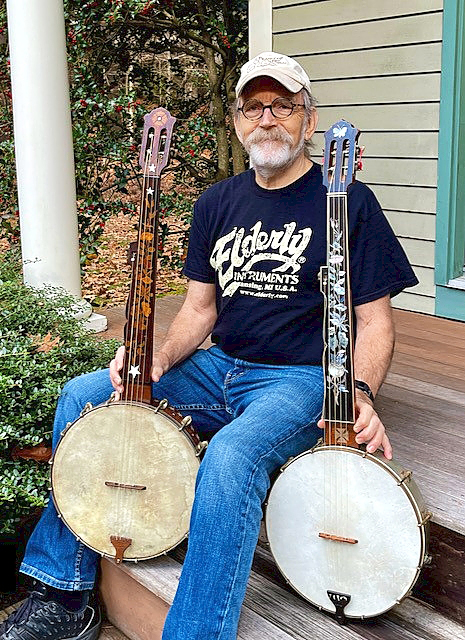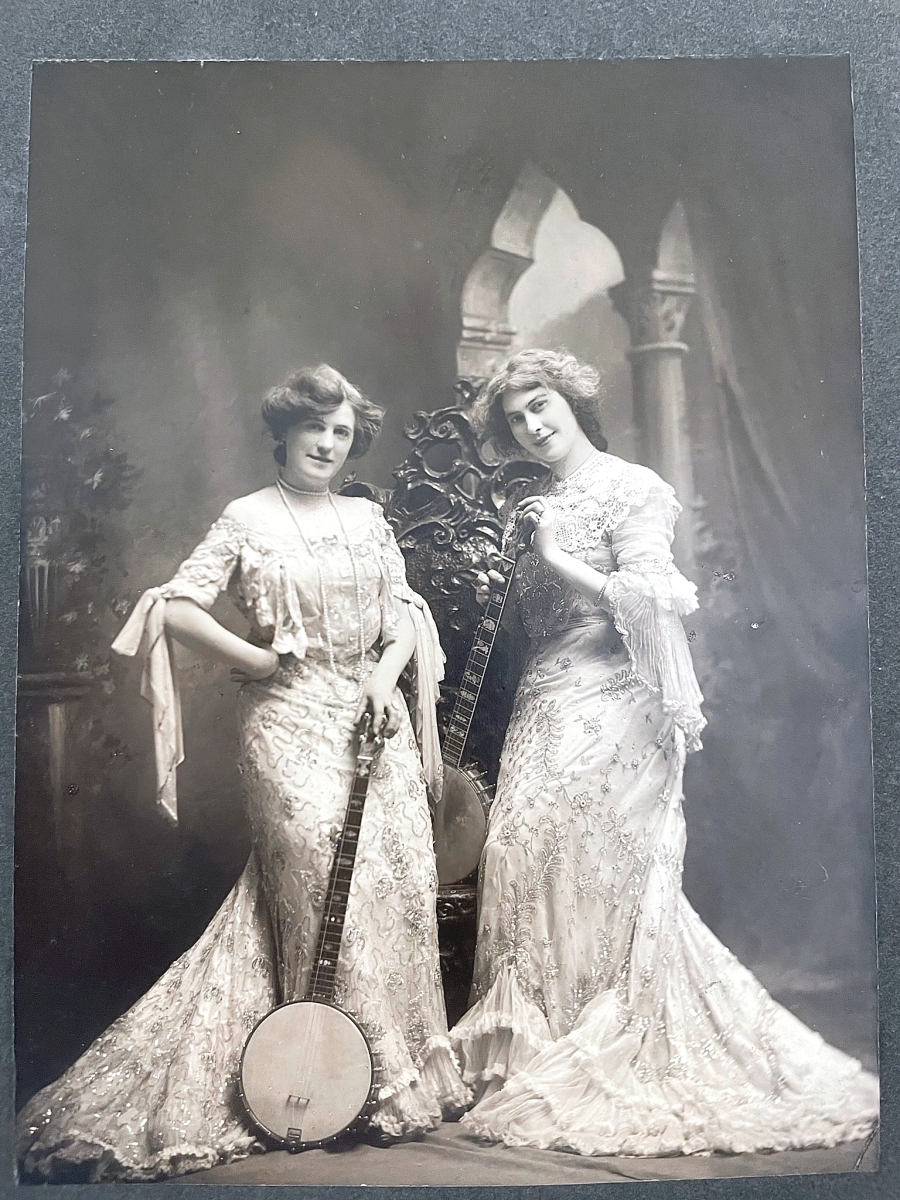
Comedian Steve Martin jokes that the difference between a guitar and a banjo is that the guitar helps you get the girl (actually, the joke is quite a bit saltier than that). There are, though, many differences separating the two acoustic instruments, and perhaps there is no one better to assess these than Jim Bollman, banjo collector and amateur historian living in the Boston area, who loves the banjo and has studied its history most of his adult life. His collection is the subject of a new exhibition at the Lyman Allyn Art Museum in New London, Conn.”America’s Instrument: Banjos from the Jim Bollman Collection,” that runs from October 8 to January 8. It features more than 50 Nineteenth Century banjos from Bollman’s unparalleled private collection, presenting the compelling stories and surprising artistry of this often overlooked, sometimes lampooned instrument and its music. We reached out to Bollman to pluck out some information on this instrument that has both African and distinctly American roots.
Can you give us a little banjo history?
Well, before the advent of bluegrass music, the banjo was a mainstay with enslaved African Americans. It has African roots and evolved from the spiked and semi-spiked lutes found in western African countries, particularly the Senegambian region. Just before the mid-Nineteenth Century, the banjo was co-opted by white minstrels for their popular but overtly racist performances. The banjo was also discovered by Southern musicians – many of them learned to play the instrument from local Black musicians. In the 1850s and 1860s, several entrepreneurs such as Samuel Stewart in Philadelphia and the Dobson brothers in New York City and Boston sought to elevate the status of the banjo – in essence, make it respectable. Frets were added to the fingerboard to facilitate ease of playing and the banjo began to be ornamented with marquetry designs and later pearl inlays to attract women – and allow manufacturers to raise their prices.

Photograph, the Carmen Sisters,
leading banjoists, circa 1902. Collection of Jim Bollman.
What styles of playing evolved?
The old minstrel style of playing, called “stroke style,” was superseded by finger-style playing, called “classic banjo,” although some rural folk musicians morphed stroke style into clawhammer, which is still popular today among folks who play old time music. The classic or finger-style banjo enabled players to widen their repertoires to include popular music, light classical music and later ragtime. The banjo moved from the minstrel stage to the concert hall by the late Nineteenth Century. Most prep schools and colleges had banjo clubs whose members performed in white tie. The banjo made it to Carnegie Hall and was very popular in the early recording industry since it performed better than many other instruments on the primitive acoustical equipment of the day.
Who were some of the era’s top practitioners?
Talented musicians, such as Fred Van Eps and Vess Ossman, were some of the most recorded performers of the era. Jazz and big band music of the 1920s and 1930s caused a seismic shift in the banjo – the drone fifth string was deleted, banjos got heavier and louder and were played with flat picks rather than fingers. Resonators and heavy tone rings were introduced to make the instruments even louder. This enabled the banjo to hold its own with loud Dixieland and big band orchestral groups. The advent of bluegrass music in the 1940s and 1950s brought back the five-string banjo but it retained the resonator and heavy tone rings of the four-string jazz era. The bluegrass banjo was and still is played with finger picks and a thumb pick. Earl Scruggs popularized a three-finger style that helped energize the music and made bluegrass one of the most exciting forms of traditional American music today. Pete Seeger popularized a long neck version of the five-string banjo – usually sans resonator during the “folk scare” of the 1960s. Many folk players were proficient in both clawhammer and picking styles. Seeger added a bunch of extra frets to accommodate his singing in lower than usual keys.
Can you explain your banjo acquisition syndrome?
My particular interest in the banjo has always centered around the instruments made in the Nineteenth Century. I consider many of the handmade ante-bellum banjos to be true folk art, although that community of collectors has never embraced the banjo in their collecting sphere. By the 1890s, banjo makers vied with each other producing custom, extremely ornate instruments to compete in important exhibitions and world’s fairs. They would then tout their gold medals in their advertising. I have a particular interest in these “presentation”-grade banjos, which exhibit the very finest artisanship of the day. Rich ornamental carving, elaborate engraved shell inlays and metal parts elevate these banjos from the utilitarian to fine art in my opinion. I’ve been lucky to collect quite a few of the best and rarest banjos from these various eras of the Nineteenth Century. My research provided material for a book, co-authored with Philip Gura, professor at UNC Chapel Hill, titled America’s Instrument: The Banjo in the Nineteenth Century,” (1990) which won an ASCAP Deems -Taylor award. This provided an apt title for the Lyman Allyn Art Museum exhibit this fall.

Mountain banjo, unknown maker, circa late Nineteenth Century. Collection of James Bollman. Photo: R.J. Phil.
Tell us about the Banjo Gathering, an annual banjo symposium for collectors, historians, dealers and anyone else interested in early banjos. How do we sign up?
With friend and fellow-collector, Peter Szego, we started a conference in 1998 for banjo history buffs and collectors. That has grown from a small group of 15 dedicated collectors to a more diverse group interested in the social history and pre-history of the banjo as well as collecting. Anyone with an interest, however great or small, in the banjo is welcome to attend our yearly weekend Banjo Gathering. I can be contacted by email at jim@fineoldbanjos.com for registration information. This year we’ll be meeting in Baltimore, Md., November, 3-6.
What are some of your key treasures in your banjo “art gallery”?
I’ve been collecting banjo-related sculpture, paintings, ceramics, photographic images, early graphics, such as broadsides, company advertising, etc., for more than 50 years along with the banjos. A small sampling of this material will be included in the exhibit. I think the banjo photographic image collection alone numbers in the thousands, including 20 daguerreotypes and numerous other Nineteenth Century images. I have a particular love for early banjo toys, which includes makers such as Jerome Secor, Ives, Guntermann, Reed, Courier, Phalibois, Vichy, etc. One of my folk art chairs will be in the exhibit – there are similar examples in the Smithsonian and Colonial Williamsburg collections.
Do you play the instrument, either solo or as part of a performing group?
I’ve played in an old-time string band named “Roustabout” for many years although age has caught up to us and we mostly play for fun these days – no more travel playing the occasional concert and many square dances like we did in the past. I’ve played in a few recordings over the years, but I consider myself a “journeyman” player not a virtuoso. I currently play a banjo made by Kevin Enoch, a wonderful craftsman in Beltsville, Md., after retiring my vintage 1909 Fairbanks banjo, which served me well over the years. Most of my playing these days is jamming with a few friends. I love the spare pure sound of just fiddle and banjo. It can be a very intimate and satisfying musical relationship.

Banjo (electric presentation model),
A.C. Fairbanks Company, Boston,
1895, 36½ by 12½ by 3½ inches.
Collection of Jim Bollman. Photo: R.J. Phil.
Are there contemporary banjos that you like?
There’s a bit of a renaissance these days both among guitar and also banjo builders. While usually lacking the amazing ornamentation of high-grade antique instruments, current luthiers are making some really great sounding and playing guitars and banjos. Friendly competition seems to be constantly improving the breed.
How do you transition from being an accumulator to a discerning collector?
My advice to budding musical instrument collectors holds true for most genres of antiques – do your homework, study the available literature, seek out experienced collectors who usually will be happy to share their knowledge, buy the best you can afford. There are many varieties of old banjos – not all are super rare and expensive, but a collecting plan rather than a simple accumulation will often be the more satisfying course. Like many collectors, I started out as an accumulator but soon realized that certain types of banjos spoke to me.
I was lucky to find a wonderful high-grade Cole banjo early on – beginner’s luck – and that set me on a path to see if I could find other similar banjos. Later my tastes expanded from simply trying to acquire fancy banjos to other types, such as minstrel-era banjos and interesting homemade Appalachian banjos we call “Mountain Banjos.” There can be traps and pitfalls to banjo collecting, especially in the area of pre-war Gibson banjos coveted by bluegrass players. The high values for which certain models are traded means that forgeries exist, so buying from reputable dealers is recommended until a great deal of expertise is acquired. Appraisals from expert dealers are worth the expense.
How would you characterize the current market for Nineteenth Century instruments?
The current banjo market is somewhat soft, meaning good deals for interesting Nineteenth Century banjos are fairly commonplace, but true masterpieces will always command strong prices, and bidder wars are not uncommon.
What do you want visitors to the Lyman Allyn exhibition of selections from your collection to come away with after seeing them?
I hope attendees to the banjo exhibit will come away with an appreciation for the complicated history, the amazing artisanship and ingenuity of the best Nineteenth Century banjo makers. There’s more to the banjo than merely being the brunt of myriad banjo jokes.
-W.A. Demers




